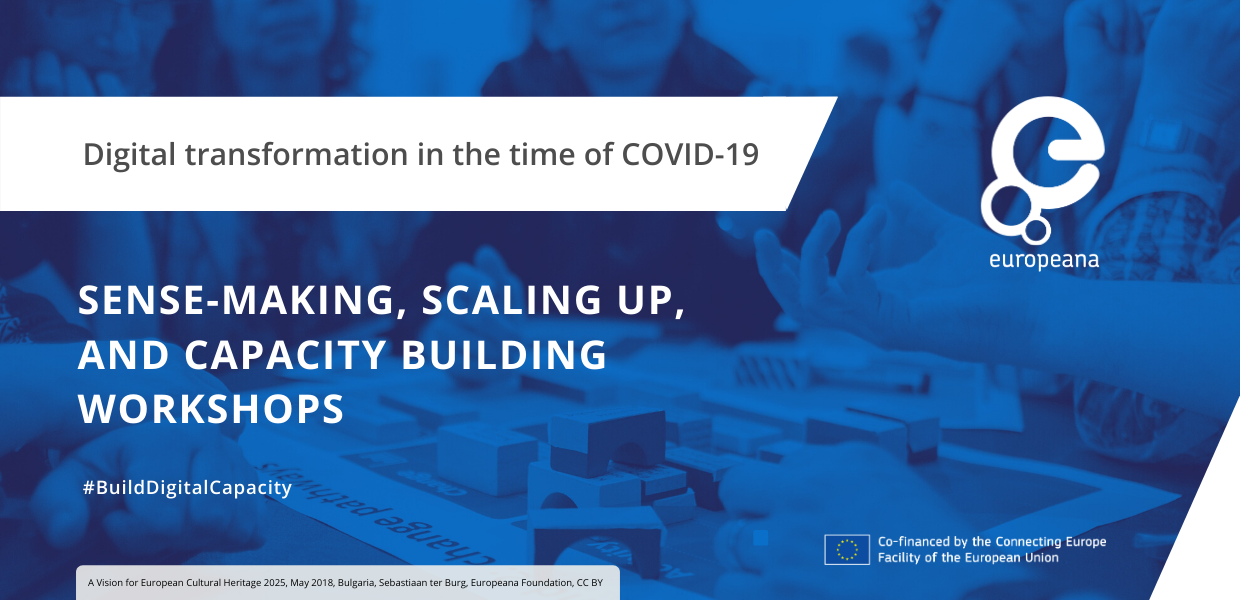Digital transformation in the time of COVID-19: edge predictions
Europeana’s June workshops on ‘Digital transformation in the time of COVID-19’ are complete, and the topics and questions they highlighted have ongoing relevance for the cultural heritage sector. In this post, Michael Peter Edson explores the ‘edge predictions’ that workshop participants imagined as the possible futures for digital cultural heritage.

- Title:
- A Vision for European Cultural Heritage 2025
- Creator:
- Sebastiaan Ter Burg
- Date:
- May 2018, Bulgaria
- Institution:
- Europeana Foundation
- Copyright:
- CC BY
What are we learning from the COVID-19 crisis, and what do these lessons tell us about where we need to go — individually, professionally, and as a sector — in the days, months, and years ahead?
Those were the big questions behind Europeana’s ‘Digital transformation in the time of COVID-19 workshops’ which concluded at the end of June. Over the course of the three-week sense-making process, Jasper Visser and I took 61 members of the Europeana community on a journey through a landscape of ideas about working, thinking, creating, and doing good in the midst of a global pandemic.
We asked participants about changes in the content they create, the tools they use, and the way they collaborate. We asked about what inspired them, troubled them, and what they have learned and seen others learn as well. And we asked them to reflect on the meaning of ‘digital transformation’ and whether we have the right tools, knowledge and values, as a sector, to be truly relevant to the people we serve.
We’ll report on the broad landscape of their reflections in the coming weeks, but looking back on it, one of the most significant questions we asked was about the edges of what these 61 digital cultural professionals might expect to see in their future work. In the final week of the workshops we asked:
Please make an edge prediction for our sector for the year 2025. An edge prediction is a prediction of something that might, but won’t necessarily, come true.
In a summary of many comments from the participants themselves (edited lightly for continuity and to obscure the identity of the speakers), this is what we heard.
Edge scenario 1. Audiences, social engagement, and societal outcomes are paramount
In 2025, the GLAM community is diverse, inclusive, and empowering. The sector has realised how important it is to communicate and engage with audiences and include new stories and narratives. GLAMs are more active in taking a stance in societal debates and the public is trusted with interpretation and input of content. Topics such as fighting fake news, racism, male dominance, inequality, supporting climate action and addressing other arising issues are better incorporated in GLAM’s mission and action than in 2020.
Edge Scenario 2. A two-speed GLAM sector
In 2025, there is a ‘two speed GLAM sector’ divided between 'traditional' institutions that focus on being neutral, physical-centric, venerable, hierarchical; and 'radical' institutions that are agents of change, digital-centric, controversial, and community-oriented. Those that are thriving are more agile, quick, digital, user-centred, market-oriented, and financially sound.
Edge scenario 3: Stagnation and failure
In 2025, the GLAM sector struggles to remain relevant and has lost its autonomy, leading to stagnation. Large parts of the GLAM sector are still struggling with fragile business models and recovering from substantial losses of funding in the political aftermath of the pandemic crisis. The sector is not dynamic — it is in decline and has become less and less influential. Governments and policymakers do not recognise culture’s benefits to social health, wellbeing, and the economy.
Edge scenario 4. Digital and physical are united as one
In 2025, the GLAM sector has blended the digital and the physical aspects of their service. The sector is in perfect harmony with online and physical presence and shares efforts on both fronts. Digital engagement has equal status as on site experiences and content and digital visitors are as important as onsite visitors and are treated like that.
Edge scenario 5. GLAMs leading the digital revolution
In 2025, the GLAM sector is known as one of the leaders in the digital revolution. Technically simple but timely and well communicated initiatives rise up next to AI, VR, and blockchain platforms to address new social circumstances. Digitisation workflows are efficient and well funded. GLAMs are so successful they have no need for financial profit: cooperation rather than competition in the digital field has led to a large communal infrastructure for arts and heritage that is an inspiration for other sectors.
Further reflections
Just a few months ago, in normal times, creating and thinking about these edge scenarios may have seemed like a trivial activity — just looking at blurry photographs from a distant landscape that had little to do with the real world. But these aren't normal times, and if the sense-making of the last few weeks is any indication, futures that once seemed impossible are now a part of our daily lives and many of the edge scenarios described by our colleagues are already partly true.
That’s the way the future usually arrives: not wholesale and from far away but piece-by-piece and now. And if that is true, and if all of the other inputs, insights, themes, observations, comments, and quirky one-off statements that we heard about over the last three weeks are any indication, the next question will have to be: what are we going to do about it? And when do we start?
Share your thoughts on Twitter with the hashtag #BuildDigitalCapacity. What are your edge predictions for digital culture, and what can the Europeana community do to steer towards better, more positive outcomes? Feel free to tag @Europeanaeu, @mpedson or @jaspervisser as well. Your insights and ideas will help us shape the conversations and outcomes of this process. If you’re interested in finding out more about the project and staying up to date with the findings, you can also register for updates.

